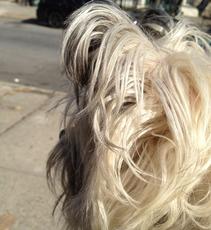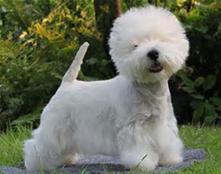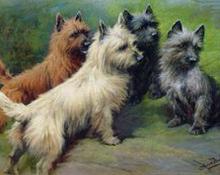DanBar Ranch
WORLD CLASS BREEDERS SPEAK:
CAIRN TERRIERS
MELITA WOOD
Melita Wood is perhaps the most respected modern breeder of cairn terriers. She bred champions for over 40 years in her British Columbia, Canada home. Countless cairn kennels were based on her fabulous dogs.
Here is what Melita Wood had to say about cairn terrier coat in a Dog World magazine article:
“Are breeders altering the cairn, or will the judges alter the standard? Take a look:
COAT: This can make or mar a cairn. THIS IS THE ONE TERRIER THAT MUST NOT BE STRIPPED FOR SHOW. (My emphasis). A very stripped out coat could be a cover-up for a poor coat.”
DanBar Ranch - Cairn Terrier Coats
Cairns are considered the oldest terrier breed in Scotland, the base root from which other breeds such as the Skye terrier, Scottish terrier and West Highland White terrier were bred. Scotland (and I've been there!) has a WET, COLD, unforgiving climate. As this breed developed, only those dogs which could survive outside living, year round, in this most unforgiving of environments survived to breed. And this included whelping pups too; there were no heat lamps, bottle feeding and vaccinations! The tough, rugged pups survived.
The cairn is today primarily a pet, however, the goal of a reputable breeder is to produce dogs which conform closely to the written "standard" of how a historical cairn should be. A functional cairn.
One of the most important aspects of a cairn is a proper working terrier coat. What defines a proper coat, or "jacket" as the hunting folk call it?
A proper jacket will afford protection to the terrier as it runs through dew covered fields, crosses brooks, ploughs through snow and works game in the cold, damp dirt underground. Most important of all attributes is that it be "waterproof". This is accomplished by having a very hard, stiff, outer coat which completely covers a soft, dense undercoat. The coat should feel harsh to the touch and lay flat enough to keep driving rain out.
The biggest fault a working terrier like a cairn can have is what is called an "open" coat; a soft, fluffy, silky coat of hair that allows water to soak to the skin, ice to hang on the coat and offers little protection from the bites of vermin.
The AMERICAN KENNEL CLUB describes a correct Cairn terrier coat:
Coat: Hard and weather-resistant. Must be double-coated with profuse harsh outer coat and short, soft, close furry undercoat.
Here are the faults the AKC lists for cairn terrier coat:
Coat: Open coats, blousy coats, too short or dead coats, lack of sufficient undercoat, lack of head furnishings, lack of hard hair on the legs. Silkiness or curliness.
The KENNEL CLUB of Scotland/UK, where the breed originated, described the breed as:
The Cairn is remarkably unchanged in appearance throughout the centuries, lighter in build than the other terrier breeds from Scotland but a game, rugged and harsh coated sporting terrier. Agile, alert, of workmanlike, natural appearance. Standing well forward on forepaws. Strong quarters. Deep in rib, very free in movement. Weather-resistant coat. Very important: weather-resistant. Must be double-coated, with profuse, harsh, but not coarse, outer coat; undercoat short, soft and close. Open coats objectionable. Slight wave permissible.
Unfortunately, show ring fads are hard for dog show people to resist. If professional handers are presenting top dogs with a specific "look", and winning, it won't be long until everyone is trying that look in hopes of winning.
Currently there is a fad for a soft, open coat, which can stand up and away from the body, especially around the head, and can then be trimmed and shaped to alter the outline of the dog, which the skilled handler/groomer can use to hide faults.
This picture illustrates the incorrect coat for a cairn. Long and silky, this is not the coat of a working terrier and would offer zero protection from wet weather and cold, harsh conditions. A cairn is to have only short hair on the ears... without having to shave or pluck them.
This is a West Highland White terrier, a breed which was, until the 1930's, cross bred with Cairns. They come from the same root stock. Show breeding has ruined the Westie's coat, and it is now almost impossible to find one with a true, tight, hard jacket. Unlike the more natural cairn, Westies are shown shaved, sculpted and with long, silky locks.
This illustration shows proper cairn terrier coat; never shaved, never silky, never dragging on the ground. This is the correct shaggy, hard jacket that must be kept on the breed. At DanBar Ranch we do our best to breed only correct coated dogs.
“A SILENT BREED KILLER written by cynolog and judge Mr. Hans Hilverda. An important food for thought for you breeders and judges
A SILENT BREED KILLER
Did you ever notice how easily judges, exhibitors and breeders get used to changes within a breed? In many cases it even goes so far that these changes are gradually lifted to the level of required characteristics. It is mostly dogs of well-known breeders / exhibitors that start a certain change (read: set a trend) within a breed.
There is for instance the somewhat bigger Miniature Schnauzer with the terrier "look "; the some what leveller, elegant looking Shih Tzu with its long neck; the Weimaraner who becomes bigger and bigger and more impressive; the "American" English Springer Spaniel, to name a few breeds.
As soon as a dog with of a slightly "deviating" –type starts winning, the ball start rolling. The dog goes to the ring of honour, the one judge bends over to his neighbour and says; "have you seen that beautiful dog?" Breeders and exhibitors notice that judges like that particular dog and start trying to breed or to buy that type of dog. At such a moment the original Breed Standard does not seem to be of importance to some exhibitors, winning in the show ring is all that matters to them.
When after some time you are sitting at the show ring looking at that breed again, it could happen that you see in a class e.g. 5 dogs of which 4 are "deviating" (deviations) from the standard next to a correct "standard" type of dog. At most shows the (correct) (complying to the) "standard" dog will be considered to be the "odd one" and the true "deviating ones" will be placed behind the boards 1 through 4. For those breeders that adhere to the Standard this is a very frustrating experience.
The temptation is of course very big. Many of the deviating dogs are often very flashy looking ones, and often show a gait, exterior and motion that looks more spectacular than the movement of the "standard" dog. One has to be very strong and come from a good breed conscience background to resist the temptations and keep on preaching the true belief and keep breeding in compliance with the standard.
Often the appearance of difference in type in a breed leads to polarisation between judges and breeders alike. One of the hallmarks of this polarisation is that certain characteristics of the dogs are even more exaggerated to make it stand out and be recognisable.
So one can observe that and conclude that the non-adherence to the standard of many breeders / exhibitors and judges poses a direct danger to the existence of our breed population.
Except for getting used to trends within a breed, the getting used and the acceptance of inherited faults is a problem of the same kind or even worse.
When judges repeatedly reward dogs with these faults with an "excellent" and also give them their championship tickets, breeders will not be challenged to improve the breed: they are already winning! In such cases only the die-hards and true idealists remain faithful to the breed and try to improve on it, but how many of those people do we have within one breed?
Accepting without any objection of changes that please the eye but are against the standard is an open invitation to the "silent breed killer" to do his job and carry out his devastating work within the breed.
Seen from the perspective that breeding is nothing more then passing on genetic material to the next generation, allowing this to happen means that one wilfully accepts and helps spreading of genetically deviating material in an irresponsible way that will pollute the gene pool (hereditary material).
Would it not be good if breeders and judges would, at least once a month take the standard at hand of the breeds they are entrusted, and what would it be valuable to organise regular meetings with breeders and judges to discuss certain trends and "faults" that creep up in a breed. Never forget that the only guideline during judging and breeding should be the FCI-approved breed standard.
So, behave and act as true disciples and spread the gospel according to the original breed standard.”
Author: Mr. Hans Hilverda
.





